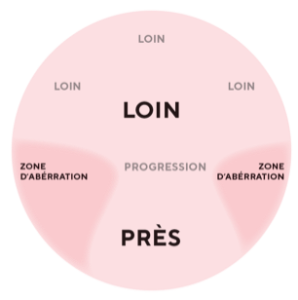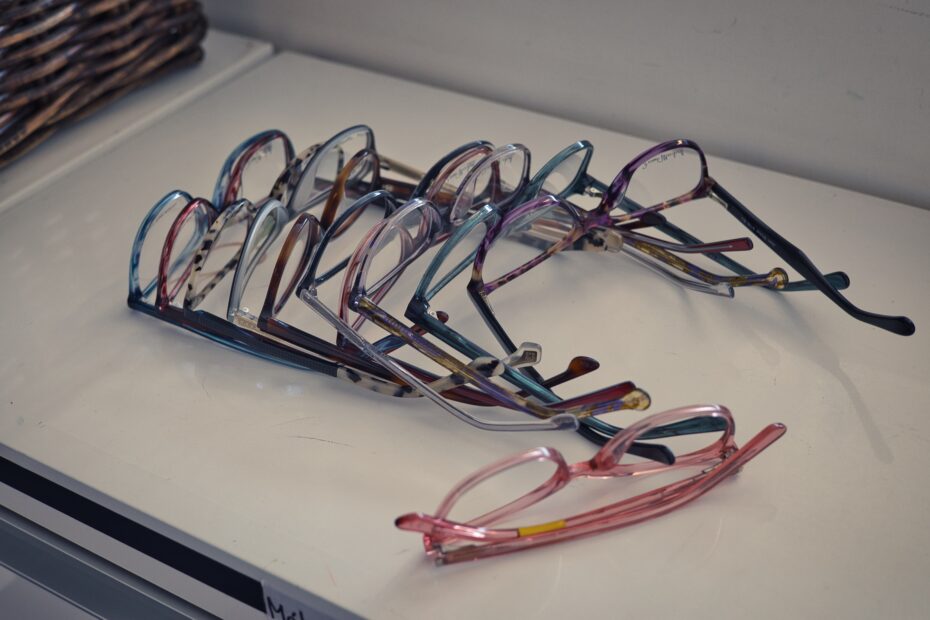When it comes to progressive lenses, you have a wide array of choices, and a wide array of prices. Typically, when major lens manufacturers announce the release of new progressive lenses with innovative technologiesYou’ll hear things like "HD, Panoramic, 360, Comfort+,” etc... For customers (and vision health professionals too!), it can be difficult to tell the difference between just plain old marketing and real technological progress.
What is a progressive lens?
Progressive lenses correct what’s known as presbyopia, the natural aging of the eye that becomes problematic around the age of 40 and makes near vision more difficult. Progressive lenses also correct other visual deficiencies (be it myopia, hypermetropia or astigmatism). That means that the customer can wear a progressive lens and see at all distances clearly (near and far) with just one pair of glasses.
Blurred Areas (also Known as Optical Aberrations) at the Periphery
By virtue of the laws of physics, progressive lenses inevitably have visual aberrations (blurriness) on either side of the lens. This means that the field of vision is smaller compared to a single vision lens:

Because of this, it takes a bit of time to get used to progressive lenses. Just how long depends on the individual, how often they wear them, and the prescription itself.
- To see far: look ahead, always through the middle of the lens. The trick is to turn your head, not just your eyes.
- To see halfway between near and far: look through the middle of the lenses, keeping your head straight.
- Near vision: always keep your head straight, but this time look down at the bottom of the glass.
- Aberration zones: avoid looking here, on either side of the lenses, since your vision here will be distorted.
- Stairs: Because each step will now appear much closer, look two or three steps ahead.
New generation progressive lenses: "Free-form" or "HD" progressive lenses
Over the past ten years, traditional lens machining has been largely replaced by digital machining, which uses point-by-point calculations. Each prescription is slightly adjusted to account for different specifications and the lenses are shaped using expensive high-precision machines. Today, almost all progressive lenses on the market are made using these technologies. These advances have made it possible to widen the visual field slightly, but the intermediate-vision zone (needed when sitting in front of a computer, for example) remains limited and the aberration zones are still present. If you work long hours in front of a computer, these types of lenses probably aren’t your best bet.
The "HD” designation can also be confusing. HD (high-definition) refers to an image by the number of pixels you see per square cm. It is not about the lens at all.
Simple Vision and Degressive Lenses to the Rescue
If you work several hours a day on a computer or if you read a lot, we at Bonhomme à lunettes will probably advise you to invest in specialized lenses. Single vision lenses offer you perfect vision over the entire surface of the lens. It's the most comfortable solution for use at a specific distance… and it also happens to be the most affordable! Bonus: you don’t need any time to train your eyes to get used to them.
If your work involves seeing at a number of different distances (if you use dual screens or read on paper and work on a computer, for example), we might recommend a degressive lens which offers you a slight variation in strength between the top and the bottom of your lens. With degressive lenses, your field of vision is wider compared to progressive lenses.
In conclusion
What do you do when the best glasses for you turn out to cost in the neighbourhood of $1,000?
We don’t work using the classic "optical care boutique marketing” approach. We offer you what we consider the best value for your money, plus we have a guarantee to ensure you can adapt to your new lenses. Regardless of price, progressive lenses might not be the best product for you. It depends on your lifestyle, your visual needs, and how your workstation is set up. That's why it's important to discuss all these details with your eye care professional.

